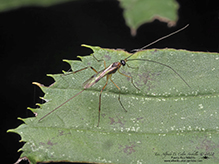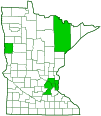Braconid wasps
(Macrocentrus spp.)
Overview • Description • Distribution • Taxonomy
Macrocentrus are predatory wasps. The larvae are internal parasites of moth caterpillars, beetle grubs, and sawfly larvae, that can be found in stems, under bark, in flower heads, or in rolled or spun leaves. In sone species, the females use their long ovipositor to insert an egg directly into the body of the host. In others, they lay an egg on the host, and when the egg hatches, the larva bores into the body of the host. The larva eventually kills the host. Some species are used as biological control agents to manage agricultural pests of corn, cotton, and soybean crops. One species, Macrocentrus cingulum, was introduced into North America in an attempt to control the European corn borer. |
||
Description |
||
Macrocentrus are slender-bodied and usually about 4 mm in length. Their color ranges from black to brick red. The head is usually dark brown to black. The back of the head (occiput) is not margined. The antennae are often longer the than body. They have 16 or more segments, a long scape at the base, a short pedicel, and a whip-like section (flagellum) with 14 or more segments (flagellomeres). The first flagellomere is much longer than the scape. The first segment of the abdomen is constricted into a narrow petiole connecting the front part (mesosoma) and rear part (metasoma) of the body. The petiole is slightly concave below. The depression at the base of the petiole (laterope) is large and deep. The metasoma is elongated. On females, the egg-laying structure (ovipositor) protruding from the rear is always as long or longer than the metasoma. The legs are long and slender. The second and smallest segment (trochanter) of each leg has peg-like teeth on the outer side at the tip. On the hind leg, the fourth segment (tibia) has an inner spur that is 0.3 to 0.5 times the length of the first segment (basitarsus) of the last part (tarsus) of that leg. |
||
Distribution |
||||
|
Sources |
|||
| 3/27/2023 | ||||
Taxonomy |
|||
Order |
Hymenoptera (Ants, Bees, Wasps, and Sawflies) | ||
Suborder |
Apocrita (Narrow-waisted Wasps, Ants, and Bees) | ||
Superfamily |
Ichneumonoidea (Ichneumonid and Braconid Wasps) | ||
Family |
Braconidae (Braconid Wasps) | ||
Subfamily |
Macrocentrinae | ||
Subordinate Taxa |
|||
braconid wasp (Macrocentrus ancylivorus) braconid wasp (Macrocentrus canariae) braconid wasp (Macrocentrus crambi) braconid wasp (Macrocentrus crambivorus) braconid wasp (Macrocentrus fuscipennis) braconid wasp (Macrocentrus grandii) braconid wasp (Macrocentrus instabilis) braconid wasp (Macrocentrus longicornis) braconid wasp (Macrocentrus marginator) braconid wasp (Macrocentrus nigridorsis) braconid wasp (Macrocentrus pallistori) braconid wasp (Macrocentrus pyraustae) braconid wasp (Macrocentrus terminalis) braconid wasp (Macrocentrus uniformis) |
|||
Synonyms |
|||
|
|||
Common Names |
|||
This genus has no common name. The common name of the family Braconidae is braconid wasps, and it is applied here for convenience. |
|||
Glossary
Flagellomere
A segment of the whip-like third section of an insect antenna (flagellum).
Metasoma
In Hymenoptera: the armored rear part of the body, consisting of the second segment of the abdomen and all segments posterior to it.
Occiput
The back of the head. In Odonata, Megaloptera, and Neuroptera, the upper part of the head behind the eyes.
Ovipositor
A tube-like organ near the end of the abdomen of many female insects, used to prepare a place for an egg and to place the egg.
Petiole
On plants: The stalk of a leaf blade or a compound leaf that attaches it to the stem. On ants and wasps: The constricted first one or two segments of the rear part of the body.
Scape
In plants: An erect, leafless stalk growing from the rootstock and supporting a flower or a flower cluster. In insects: The basal segment of the antenna.
Tarsus
On insects, the last two to five subdivisions of the leg, attached to the tibia; the foot. On spiders, the last segment of the leg. Plural: tarsi.
Tibia
The fourth segment of an insect leg, after the femur and before the tarsus (foot). The fifth segment of a spider leg or palp. Plural: tibiae.
Visitor Photos |
|||||
Share your photo of this insect. |
|||||
| This button not working for you? Simply email us at info@MinnesotaSeasons.com. Attach one or more photos and, if you like, a caption. |
|||||
Alfredo Colon |
|||||
 |
|||||
MinnesotaSeasons.com Photos |
|||||
|
|||||

Slideshows |
||

Visitor Videos |
|||
Share your video of this insect. |
|||
| This button not working for you? Simply email us at info@MinnesotaSeasons.com. Attach a video, a YouTube link, or a cloud storage link. |
|||
Other Videos |
|||
| Macrocentrus | Braconidae aagaa vanam |
|||
About
Mar 23, 2022 Macrocentrus is a genus of braconid wasps in the family Braconidae. These small wasps have narrow waists, long antennae, and ant-like heads, usually less than 0.5 inch long. They have a long black ovipositor extending from their rear ends. They have orange or reddish abdomens. Braconid wasps do not sting. Flower nectar and pollen are major energy sources for braconid wasps. |
|||

Created: 3/27/2023
Last Updated:


